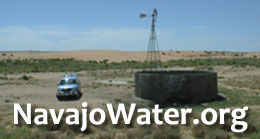The following is the transcript of a speech given by Groundswell’s Navajo intern Rita White on Earth Day 2010 at a Diné College screening of “The Return of Navajo Boy.”
Yá’áh’tééh, my name is Rita White. My clan is Tlaash’chi nishli, Bitaahni baashinchiin, Tlizilani das hi cheii, Taabahi das hi nail. I am a student from the Shiprock Diné College and the President of the Diné Ecology Club (DECO Club). I am majoring in Environmental Science and plan to go into Environmental Law for my BA.
As student President for Diné Ecology Club (DECO Club), not only is making the clubs thrive important to me, the environment I live in concerns me. Nowadays we have huge issues like global warming and climate change to face and our generation will definitely feel the effects of today’s actions or non-actions in the future. Recently, I have seen changes in my environment because of global warming and I cannot imagine what the future will bring. This letter is not only for me but future generations as well.
As you view the film, please keep in mind the impacts past nuclear industries, related to former uranium mines and mills have caused on the Navajo reservation. These impacts are many and diverse:
1. Mine waste left scattered all over the Navajo reservation, contaminating our lands, air and water.
2. Contaminated homes and structures from radioactive materials associated with mine waste.
3. Impacts to our lands, air, water, our plants and animals: all precious resources for the Navajo.
4. The impacts to human health: birth defects, DNA damages, cancer among miners and millers, non-malignant respiratory disease.
5. Compensation programs that are arbitrary and unfair to Native Americans, not recognizing tribal customs and traditions.
6. Lingering issues with mine and mills that are listed in the Navajo Nation’s 5 Year Plan
7. Psycho-social impacts documenting the hardships, victims and families endure as the aftermath of the uranium industries. How do these families cope after seeing their dads, uncles, and grandfathers die from exposure, the lack of school due to their fathers’ illnesses, the lack of adequate treatment and care by Indian Health Service, etc..
As you view the movie, also pay particular attention to other major impacts such as how they treated Navajos by taking loved ones out of homes, much like how the young was removed homes and placed in BIA schools. The system still used the Manifest Destiny concept of the BIA boarding school days.
The film also documents the need for more students’ involvement in the science careers: engineers, environmentalists, public health careers, biologists, chemistry, and forms of science careers. You need to go on and become researchers, scientists, educators, leaders to address these mistakes and impacts from the past. Our natural resources are being exploited and many times misused, so we need you to go out, get educated and return to assist your people.
We need to explore other forms of energy development such as wind and solar energy.
This is what the movie is all about, to allow you to think critically as a Native American student so you can determine your careers and make wise choices. Although we are faced with these challenges, we have a huge opportunity to make a positive change, and I want to be a part of it. Again, I urge you to keep in mind the impacts past nuclear industries related to former uranium mines and mills have caused on the Navajo reservation. ‘Ahxe’hee’!














Leave a Reply
You must be logged in to post a comment.